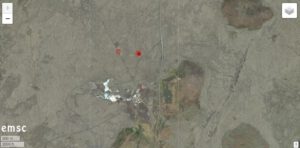 There was another strong earthquake in Iceland this morning. It had a magnitude of 4.1 and manifested itself on the Reykjanes Peninsula. The epicentre was located 4.1 km north of Grindavik and only about 1 km from the Blue Lagoon and Thorbjörn Volcano. The depth of the hypocentre is estimated to be only 2.5 km. This makes it the closest surface earthquake of this magnitude since the swarm earthquakes started on the peninsula. The local residents should have been well shaken. It remains exciting to wait and see whether reports of crevice openings will come in. Just 2 minutes earlier, there was a quake of magnitude 3.2 at a depth of 2.3 km. Further weaker earthquakes followed. In total IMO registered 40 tremors on Reykjanes in the last 48 hours.
There was another strong earthquake in Iceland this morning. It had a magnitude of 4.1 and manifested itself on the Reykjanes Peninsula. The epicentre was located 4.1 km north of Grindavik and only about 1 km from the Blue Lagoon and Thorbjörn Volcano. The depth of the hypocentre is estimated to be only 2.5 km. This makes it the closest surface earthquake of this magnitude since the swarm earthquakes started on the peninsula. The local residents should have been well shaken. It remains exciting to wait and see whether reports of crevice openings will come in. Just 2 minutes earlier, there was a quake of magnitude 3.2 at a depth of 2.3 km. Further weaker earthquakes followed. In total IMO registered 40 tremors on Reykjanes in the last 48 hours.
 Marc Szeglat
Marc Szeglat
Raung: Eruption started
 On the Indonesian island of Java, the volcano Raung has started an eruption. The eruption was preceded by a seismic crisis. It started on July 13th. The first small ash cloud was detected 2 days ago. A VONA warning was issued and air traffic on the neighbouring island of Bali was suspended. However, due to the corona lockdown, only very few flights may have been affected. In the meantime a stable eruption on a low level has occurred. During the first 6 hours of the day, volcanologists from VSI recorded 28 seismic eruption signals. They had amplitudes between 4 and 14 mm and lasted up to 150 seconds. MIROVA recorded a moderate thermal anomaly with peak values of 15 MW. One can assume strombolian activity, where glowing tephra accumulates in the crater. The alert status has been raised to “yellow.”
On the Indonesian island of Java, the volcano Raung has started an eruption. The eruption was preceded by a seismic crisis. It started on July 13th. The first small ash cloud was detected 2 days ago. A VONA warning was issued and air traffic on the neighbouring island of Bali was suspended. However, due to the corona lockdown, only very few flights may have been affected. In the meantime a stable eruption on a low level has occurred. During the first 6 hours of the day, volcanologists from VSI recorded 28 seismic eruption signals. They had amplitudes between 4 and 14 mm and lasted up to 150 seconds. MIROVA recorded a moderate thermal anomaly with peak values of 15 MW. One can assume strombolian activity, where glowing tephra accumulates in the crater. The alert status has been raised to “yellow.”
The last eruptions of the Raung occurred in 2015, when the eruptions started like now and increased within a few weeks to a very interesting eruption, where not only strombolian eruptions were generated, but also lava flows that filled part of the crater.
Andaman: Earthquake M 6.1
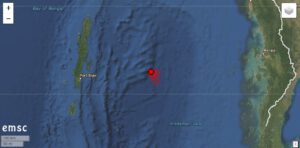 The Andaman and Nicobar Islands were shaken by an earthquake with a magnitude of 6.1. The hypocentre was 10 km deep. The epicentre manifested 236km east of Port Blair. The Indian Ocean archipelago belongs to India, but geographically it is closer to Myanmar. An aftershock of magnitude 5.6 followed at a depth of only 2 km. There had also been several aftershocks in the 4-magnitude range. Seismologists have been expecting a strong quake in the region (Andaman Sea) for some time, which could trigger a tsunami.
The Andaman and Nicobar Islands were shaken by an earthquake with a magnitude of 6.1. The hypocentre was 10 km deep. The epicentre manifested 236km east of Port Blair. The Indian Ocean archipelago belongs to India, but geographically it is closer to Myanmar. An aftershock of magnitude 5.6 followed at a depth of only 2 km. There had also been several aftershocks in the 4-magnitude range. Seismologists have been expecting a strong quake in the region (Andaman Sea) for some time, which could trigger a tsunami.
The quake was automatically detected.
Nishinoshima grows
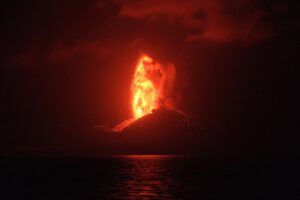 The Japanese volcanic island of Nishinoshima is growing and growing and is not only producing lava flows but also ash clouds. On 13. July these reached an altitude of 6100 m, with a cone height of 200 m.The Japanese coast guard photographed lava fountains that were as high as the cinder cone. Today the activity seems to be decreasing. The VAAC recorded volcanic ash at an altitude of 3700 m.
The Japanese volcanic island of Nishinoshima is growing and growing and is not only producing lava flows but also ash clouds. On 13. July these reached an altitude of 6100 m, with a cone height of 200 m.The Japanese coast guard photographed lava fountains that were as high as the cinder cone. Today the activity seems to be decreasing. The VAAC recorded volcanic ash at an altitude of 3700 m.
New observations will be made on July 20 by the meteorological observation ship “Keifu”.
Sangay: Thermal anomalies detected
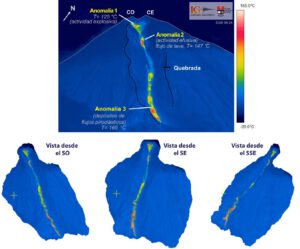 The Ecuadorian volcano Sangay is still active. Today, explosive eruptions were detected, which caused volcanic ash to rise to an altitude of 6400 m. The ash was drifted westward. In a special report of the IGEPN the morphological changes of the volcano caused by the eruptions were investigated. Most striking is a depression on the southeast flank. It was carved into the flank by lava flows, debris avalanches and pyroclastic flows. The gorge is almost 400 m wide, 4 km long and starts from the crater. Three thermal anomalies have been detected in it. 2 of the anomalies are located in the upper part of the canyon. The top anomaly is in the crater area and marks an explosive vent. The 2nd anomaly is below the base of the crater and represents the source of the lava flows. The 3rd heat source is located in the lower part of the gorge and is probably generated by an accumulation of hot deposits of pyroclastic flows.
The Ecuadorian volcano Sangay is still active. Today, explosive eruptions were detected, which caused volcanic ash to rise to an altitude of 6400 m. The ash was drifted westward. In a special report of the IGEPN the morphological changes of the volcano caused by the eruptions were investigated. Most striking is a depression on the southeast flank. It was carved into the flank by lava flows, debris avalanches and pyroclastic flows. The gorge is almost 400 m wide, 4 km long and starts from the crater. Three thermal anomalies have been detected in it. 2 of the anomalies are located in the upper part of the canyon. The top anomaly is in the crater area and marks an explosive vent. The 2nd anomaly is below the base of the crater and represents the source of the lava flows. The 3rd heat source is located in the lower part of the gorge and is probably generated by an accumulation of hot deposits of pyroclastic flows.
Piton de la Fournaise: No eruption upcoming
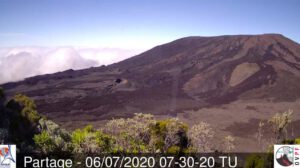 The seismic crisis started on July 3, 2020 at 07:20 local time and ended around 08:00 local time. This episode was accompanied by surface deformations which remained extremely weak and localized at the top of the Piton de la Fournaise. Since then, no resumption of seismic activity or deformation has been observed.
The seismic crisis started on July 3, 2020 at 07:20 local time and ended around 08:00 local time. This episode was accompanied by surface deformations which remained extremely weak and localized at the top of the Piton de la Fournaise. Since then, no resumption of seismic activity or deformation has been observed.
Several hours without any activity being observed are evidence of the deep stop of magma in the building.
Nevertheless, given the resumption of inflation observed since June 16, a medium-term eruption cannot be ruled out.
Popocatepetl: Volcano with spirit
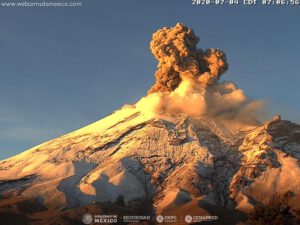 Close to the Mexican capital the Popocatepetl is still active. Yesterday the CENAPRED Institute published a very atmospheric photo of a sunset eruption. Besides the explosion, 169 ash-steam exhalations and 32 minutes of tremors were recorded. Today, explosive volcanic eruptions were also recorded: the VAAC issued 2 VONA messages according to which volcanic ash had risen to an altitude of 5800 m.
Close to the Mexican capital the Popocatepetl is still active. Yesterday the CENAPRED Institute published a very atmospheric photo of a sunset eruption. Besides the explosion, 169 ash-steam exhalations and 32 minutes of tremors were recorded. Today, explosive volcanic eruptions were also recorded: the VAAC issued 2 VONA messages according to which volcanic ash had risen to an altitude of 5800 m.
Popocatepetl has become a permanently active volcano in recent years. Only seldom there are longer pauses in eruption. In addition a lava dome grows sporadically in the crater. The ascent is prohibited.
Merapi: new dome growth
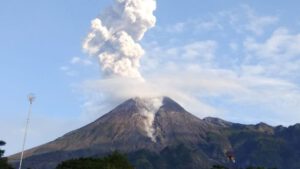 On the Indonesian website krjogja.com it is reported that the Merapi has entered a new phase with dome growth. This information comes from Agus Budi Santoso, the head of the Merapi Volcano section at the BPPTKG. The new intrusion is the 7th phase since the beginning of the eruption and is accompanied by explosive activity and deep seismic. The larger eruptions in the first half of the year would have more than halved the volume of the lava dome to 200,000 cubic metres. Now it looks as if the dome is getting bigger again, increasing the potential danger.
On the Indonesian website krjogja.com it is reported that the Merapi has entered a new phase with dome growth. This information comes from Agus Budi Santoso, the head of the Merapi Volcano section at the BPPTKG. The new intrusion is the 7th phase since the beginning of the eruption and is accompanied by explosive activity and deep seismic. The larger eruptions in the first half of the year would have more than halved the volume of the lava dome to 200,000 cubic metres. Now it looks as if the dome is getting bigger again, increasing the potential danger.
Nishinoshima: Eruption increased
 The Japanese island volcano Nishinoshima continues to make headlines. The VAAC issued numerous VONA warnings of ash clouds. Currently volcanic ash is registered at an altitude of 7300 m above sea level. Since the cinder cone is only a few 100 m high, this represents a remarkably large eruption cloud. The peak value yesterday was 4200 m and was described in Japanese media as the highest ash cloud since the beginning of the eruption. The thermal radiation yesterday had a power of 1860 MW and is therefore also in a very high range. So lava flows are still being produced, which will change the face of the island forever. Nishinoshima is growing and growing. Radar images show that not only the coastline is constantly shifting, but also the cinder cone with the explosive crater is subject to major changes. It looks as if a major collapse has occurred in the south of the cone. Probably the collapse was caused by a new lava flow.
The Japanese island volcano Nishinoshima continues to make headlines. The VAAC issued numerous VONA warnings of ash clouds. Currently volcanic ash is registered at an altitude of 7300 m above sea level. Since the cinder cone is only a few 100 m high, this represents a remarkably large eruption cloud. The peak value yesterday was 4200 m and was described in Japanese media as the highest ash cloud since the beginning of the eruption. The thermal radiation yesterday had a power of 1860 MW and is therefore also in a very high range. So lava flows are still being produced, which will change the face of the island forever. Nishinoshima is growing and growing. Radar images show that not only the coastline is constantly shifting, but also the cinder cone with the explosive crater is subject to major changes. It looks as if a major collapse has occurred in the south of the cone. Probably the collapse was caused by a new lava flow.
Livecam Fuego
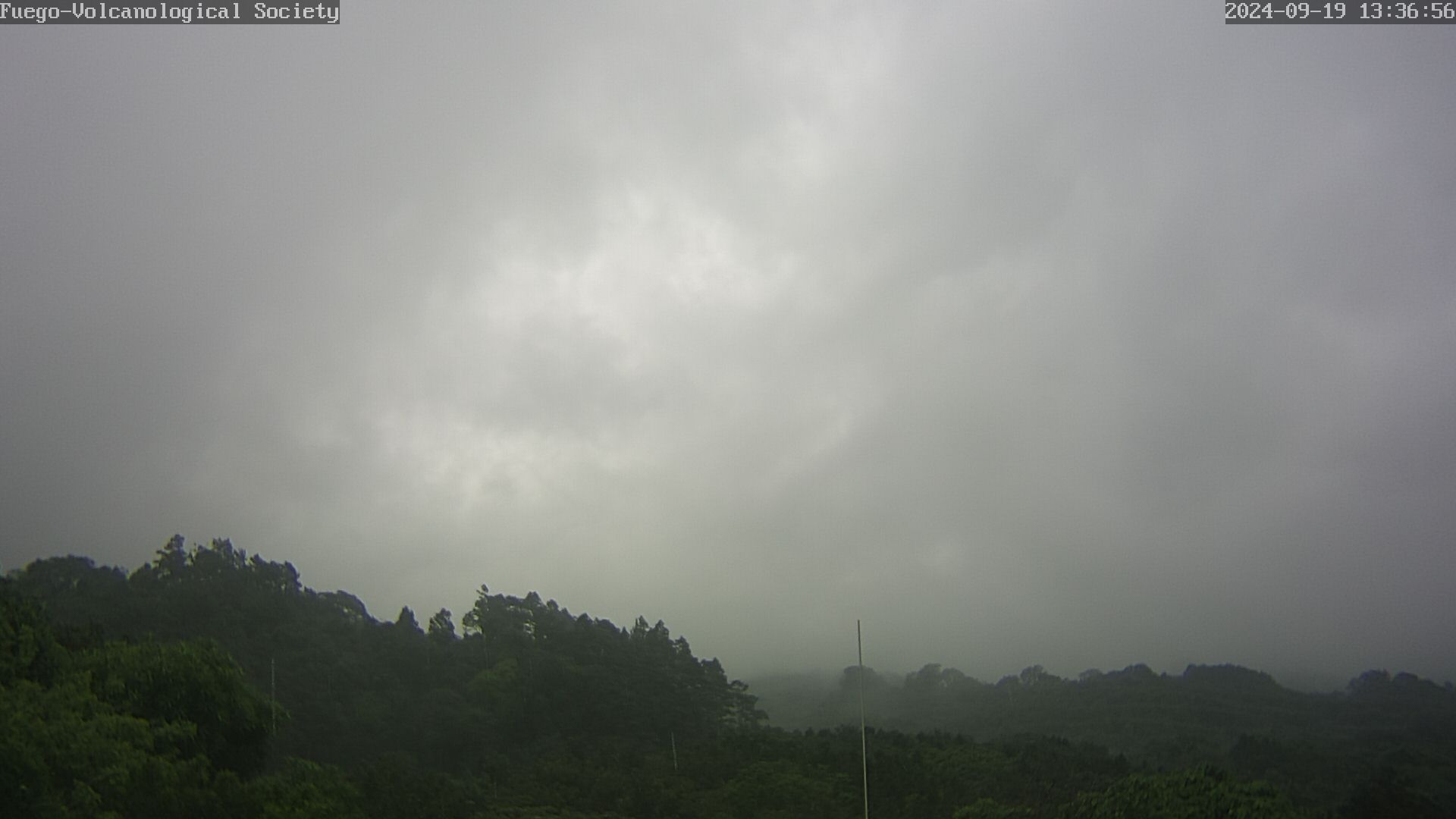
The Webcam was installed by Marc Szeglat (vulkane.net) in cooperation with the Volcanological Society e.V.. To load a new image, please update the page.
The Livecam is located at the foot of the volcano Fuego, not far from the old golf course near La Reunion. Special thanks to Ulrich Schirmer, on whose property the camera is located.